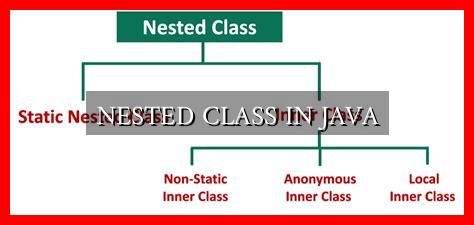-
Table of Contents
The Power of Nested Classes in Java
When it comes to object-oriented programming, Java is a powerhouse language that offers a wide range of features to developers. One such feature that often goes underutilized is nested classes. Nested classes in Java provide a powerful way to encapsulate logic and improve code organization. In this article, we will explore the concept of nested classes in Java, their types, benefits, and how they can be effectively used in real-world scenarios.
What are Nested Classes?
In Java, a nested class is a class that is defined within another class. This means that the nested class is a member of the enclosing class and has access to its members, including private members.
. There are four types of nested classes in Java:
- Static Nested Class: A static nested class is a static member of the enclosing class and does not have access to the instance variables of the enclosing class.
- Non-Static Nested Class (Inner Class): An inner class is a non-static member of the enclosing class and has access to the instance variables of the enclosing class.
- Local Inner Class: A local inner class is defined within a method and has access to the local variables of that method.
- Anonymous Inner Class: An anonymous inner class is a local inner class without a name that is used for one-time use.
Benefits of Nested Classes
Nested classes offer several benefits that can improve code readability, maintainability, and encapsulation:
- Encapsulation: Nested classes can encapsulate logic within the scope of the enclosing class, reducing the complexity of the code.
- Code Organization: By grouping related classes together, nested classes can improve code organization and make it easier to navigate and maintain.
- Access Control: Nested classes have access to private members of the enclosing class, allowing for better control over data access.
- Code Reusability: Nested classes can be reused within the scope of the enclosing class, promoting code reusability.
Real-World Example
Let’s consider a real-world example of using nested classes in Java. Suppose we have a Car class that represents a car object. We can define a nested class Engine within the Car class to encapsulate the logic related to the car’s engine:
“`java
public class Car {
private String model;
public class Engine {
private int horsepower;
public Engine(int horsepower) {
this.horsepower = horsepower;
}
public void start() {
System.out.println(“Engine started with ” + horsepower + ” horsepower”);
}
}
}
“`
In this example, the Engine class is a nested class within the Car class, allowing us to encapsulate the engine-related logic within the scope of the Car class.
Best Practices for Using Nested Classes
When using nested classes in Java, it is important to follow some best practices to ensure clean and maintainable code:
- Avoid Deep Nesting: Limit the depth of nested classes to avoid overly complex code.
- Use Static Nested Classes for Utility Classes: Use static nested classes for utility classes that do not require access to instance variables.
- Keep Nested Classes Small and Focused: Divide logic into smaller nested classes to improve readability and maintainability.
Conclusion
Nested classes in Java provide a powerful way to encapsulate logic, improve code organization, and promote code reusability. By understanding the different types of nested classes and following best practices, developers can leverage nested classes to write clean and maintainable code. Whether it’s encapsulating related logic within a class or creating utility classes, nested classes offer a versatile tool for Java developers.
For more information on nested classes in Java, you can refer to the official Java documentation here.





